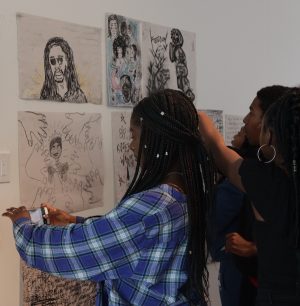In the last decade, Black artists have put Canada on the map. Across the globe, contemporary Canadian culture is recognized as the look, sound and feel of Black Canada. Musicians like Kardinal Offishall, Drake and Kaytranada, and producers like WondaGurl have made defining contributions to global popular culture in the last decade. Despite the cultural and economic contributions we’ve made, we continue to see a reluctance from institutions to invest in Black Canadian artistic production. In the 15 years that Nia Centre for the Arts has operated, we’ve seen that art is a life-sustaining practice. The organization was borne out of the recognition that our communities thrive when we invest in their creativity.

School Engagement: A class at Toronto’s Etobicoke School of the Arts participates in an exhibit, “Ears, Eyes, Voice.” Photo is courtesy of Nia Centre.
Black youth too often find themselves discriminated against in our schools, in the media and when navigating the public sphere. Yet, everyday we see young people enthusiastically using their talents to envision a different kind of world. Our work began in 2008, as a response to increased youth violence in Toronto. From early on, our founders recognized the power of art to act as a lifeline to young people. Since then, we’ve developed a holistic approach to working with young people that honors their creativity.
The Work
Nia Centre has three organizational pillars: introducing youth to the arts, supporting local artists and creating opportunities for Canadians to experience art from the Black diaspora. Through our in-house programming, we connect young people to established mentors in the arts sector, provide artists with skills-building workshops and link young people to career opportunities in the arts. Young people who engage with The Centre frequently receive opportunities to showcase their work to the public, helping them to build their portfolios and reach new audiences.

“Thank You for Keeping Us on Track,” by Jordan Sook, one of three art exhibits at “Here Again, At the Crossroads,” presented by Nia Centre and Union Station and shown at Union Station, in Toronto. Photo by Spring Morris. See end of this article for links to Sook and the exhibit.
In a city as diverse as Toronto, it’s important for people to engage with artists who make meaning out of our collective experience. In the last few years, we’ve brought public art projects to Harbourfront Centre, Union Station and along the Ossington corridor. Each of these projects invited citizens to engage with Black cultural production in public spaces where our voices had often gone unheard.
A fourth, and still developing, pillar of our work is documenting our community. Canada’s decision to not collect race-based data has made it difficult to uncover the true impact of systemic racism in the lives of Black Canadians. In the last few years, it has become increasingly clear that in order to create change in our community we have to begin collecting data ourselves. Last year, we began a research project on online hate and anti-Blackness. Through a nationwide survey and a number of dedicated focus groups and interviews, we’re tracking the impact of anti-Blackness online. As an arts organization, we recognize the importance of including artists’ voices in conversations about larger social issues. The research findings have been interpreted by a number of selected artists, who will be exhibiting their works later this year.
The Challenges

Nia Centre for the Arts is located at 524 Oakwood Ave., in the historic neighborhood of Little Jamaica, in Toronto. The neighborhood has become collateral damage to the Eglinton Light Rapid Transit development, rapidly rising rent prices and devastation as a result of the Covid pandemic. Still, local residents, businesses and organizers continue to build a new future for the neighborhood. Photo is courtesy of Nia Centre.
The work of an organization like ours is to uplift and support the people we serve. This responsibility becomes increasingly difficult each year, as expenses rise and funding doesn’t. As a nonprofit organization, finding consistent funding has always been our biggest challenge. At Nia Centre, we find ourselves at a difficult intersection between lack of funding for Black charities and a lack of funding for the arts sector.
A report (Unfunded: Black Communities Overlooked by Canadian Philanthropy), by the Foundation for Black Communities and Carleton University, found that only seven to 30 cents of every $100 donated in Canada goes to Black-led charities. Additionally, a majority of the Black community organizations that participated in the study indicated that they will run out of funding in less than six months.
These numbers are staggering, considering that Black charities play integral roles in our communities when local and federal governments fail us. In the last two years, the pandemic has decimated the arts sector, and our biggest funders have been unable to keep up with inflation and the increasing financial pressure on our community. This reality makes it increasingly difficult to provide services to the ever-growing number of youth and artists in search of support.
The Pathway

Alica Hall, Executive Director of Nia Centre for the Arts.
Acquiring a physical space has always been a top priority for us. Black artists are the heartbeat of Toronto, and yet, there’s no dedicated gathering place where people can connect to their work. In 2020, we announced that we’re building Canada’s first, multi-disciplinary, professional art facility. Located in Little Jamaica, a historically Caribbean neighborhood, the Centre features a 150-seat theater, studio space, a digital media lab and a youth hub.
In a city where space is increasingly financially inaccessible and often racially discriminatory, it’s important that Black communities have spaces in their neighbourhood that serve them. The facility is a space where young people, local artists and community members can create and dream. We offer a place where people can experience art, divorced from imposed notions of what “Black art” should be.
We’ve been working on the front lines of preserving and nurturing Black artistic talent in Toronto for over a decade. In that time, it’s become increasingly clear the Black artistic traditions aren’t valued by the philanthropic or government sector in the same way that Eurocentric traditions are. What we know about our society changes when we make space for new stories and new experiences. This kind of knowledge is what Black art offers us, and is exactly why it’s so urgent that Canadians see it as their duty to support local artists.
Nia Centre for the Arts is @niacentre on all social media platforms. Jordan Sook’s “Thank You for Keeping Us on Track” is one of three exhibits in “Here Again, At the Crossroads” at Toronto’s Union Station.
Monday, May 30, 2022 in Arts, For homepage, Social Justice & Change, Unfunded & related stories
Share: Twitter, Facebook



